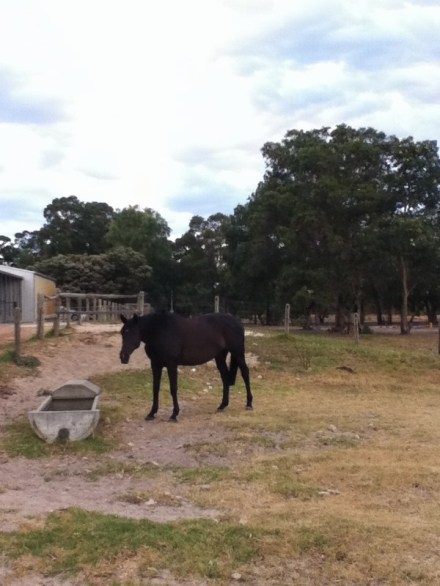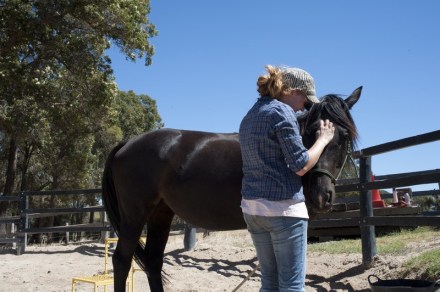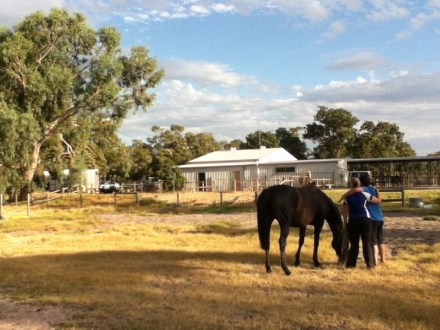How do you come to terms with euthanising a horse still in the prime of their life? Even if they will never be riding sound? On Wednesday afternoon I went with my good friend to enjoy being with her horse for the last time, and say my final goodbye.
We put her beautiful black mare in the round yard, to free lunge her to check that she was definitely lame. She had been groomed and her tail was trimmed. She looked ready to go to a hack show the next day. Instead, the appointment with the vet and the livestock removal company had already been booked for the following day. My friend just wanted to be sure, she wanted me to confirm that the lameness she saw was really there. The mare was definitely uncomfortable moving at a trot, but her good nature and willingness to try meant she trotted in spite of the pain it cost her. You could see she was trying for her owner.
Ruby, a nine year old Thoroughbred, is chronically unsound. But she’s not old, not obviously sick or injured. It’s not something you can look at and see that putting her down is the right thing to do. And yet, it is the right thing to do.
She has always been a bucker, and last year my friend finally discovered why, when she had Ruby’s front end ultrasounded and x-rayed and nerve blocked. The culprit was arthritis. Two of the vertebrae in her shoulder are fused, and inflammation in the area puts pressure on a nerve, which can launch her into a reactive bucking fit. Before this, my friend had done everything that you can do for a lame horse. Corrective shoeing, joint supplements, massage and chiro treatments, anti-inflammatory injections, new saddle, new farriers, new trainers, new vet. Shoulder lameness is said to be rare and very difficult to treat, after all, 70% of a horse’s body weight is carried on the front end. Vets are reluctant to diagnose shoulder lameness, prefering to exhaust every other possibility first. That’s how it took years to find out why Ruby always went lame, and why she was prone to bucking.
Ruby could have a nerve twinge at any time. Any number of things could set her off bucking. She has a beautiful nature otherwise, such a sweet and gentle girl. The bucking is simply a reaction to pain, but it makes her unpredictable and dangerous to ride. Three years ago, the pair were at a one day event, and with little warning Ruby bucked my friend off into a coffin jump. It was clear the mare was dangerous but my friend loved her and didn’t want to give up on her. After three years of trying everything, from having the mare professionally retrained to injecting steroids directly into the inflamed joint, my friend finally reached the point where there was little more she could do, or had the energy to do. There has to be a limit to what you will do to save a horse.
We had talked about the possibility of euthanasia last December, after Ruby had had a consult at the only vet clinic in Western Australia specialising in treating lameness. They were going to try a relatively new direct injection joint treatment on her in an attempt to bring down the inflammation, requiring ultrasound to locate the site of injection. The efficacy of this treatment is apparently highly variable and I don’t fully understand how it works, myself. Some horses have improved mobility and pain relief for up to twelve months, in other horses it makes no difference. There is no way to tell how a horse will respond. It is truly the last resort.
My friend was also working with a new instructor to help slowly build up Ruby’s fitness and topline muscles, to support her spine and improve her ability to carry more of her weight on her back end, taking the strain off the shoulder. After a month and a half of working in walk and trot only, Ruby pulled up sore and lame last week after beginning work over poles. Her back end had gone sore, and as a result she was traveling more on her forehand to avoid the back end soreness, which had then triggered pain in her shoulder. The injection had given her less than two months of relief. It was proof that she would never be riding sound. She would certainly never be able to jump again.
“You want to have a sit?” My friend asked me, after we had worked Ruby in the round yard for about ten minutes. Her back end was no longer sore, but she was clearly uncomfortable in the shoulder. It was really just a last check to be sure – the date was already set. This would be her last evening ever, my last chance. So I had a sit on her, bareback, in the gentle sunlight interrupted by faltering gumtree shadows. A last sit, although it didn’t feel that final at the time. The day had been hot but the afternoon was cool and though you could hear cars, you couldn’t see them. It was peaceful. Ruby had no halter or bridle on, and after a false start where she walked off without being asked, I backed her up using my legs and held onto a handful of mane. Even if I didn’t know Ruby was a habitual bucker, I would have grabbed mane anyway. I am a nervous rider. I do my best not to show it.
My friend asked Ruby to walk on in a circle, using body language cues. Ruby walked on. She did not feel like a horse that was going to die the next day. Her back was padded up with muscle and fat, glossy with health and comfortable like an armchair. As she stepped around in a slow circle, I could feel her muscles gently rolling under me, from her hindquarters to her back to her cursed shoulder. I moved her sideways with just the lightest touch of my leg. She felt amazing. I felt unworthy of being on her back, clumsy and unbalanced. I patted her neck over and over. She was so soft. Like always, I didn’t want to get off.
My friend had spoken to lots of people about Ruby’s condition over the past months, and several people offered to take Ruby as a broodmare, but I am proud that my friend did the responsible thing and turned them all down. Carrying the weight of a foal is just as much a burden on a mare’s joints and spine as a human rider. And I have never understood the mentality of breeding from a mare that is structurally unsound – “only breeding sound”. It’s like flipping a coin and hoping your foal doesn’t get the same genetic weakness. Ruby’s arthritis most probably developed as a result of being started too young, possibly combined with an existing skeletal defect. Most Thoroughbreds are not robust to begin with, being bred for speed not soundness. The racing industry’s drive for profit sees horses racing at just two years old, putting undue wear on bodies that aren’t done growing yet. All the more reason to breed for fortitude and long term soundness. Why would you want to take the chance?
Being retired as a paddock ornament was simply not an option for Ruby, either. Although paddock rest would initially provide relief from soreness, there would be no guarantee that she would remain pain-free, and any hooning or high spirits could twinge the nerve and risk further injury.
Thankfully the majority of people have been understanding and supportive of the decision to euthanise. After all, every possible treatment has been tried. I have watched the last few months as my good friend worked herself ragged, learning to ride in a new position that would keep the weight off Ruby’s shoulder, and committing to riding four to five days a week to improve the mare’s fitness, while working full time. In the end, this has worn her down, and the fun of riding has gone and been replaced with the fear of being bucked off and hurt. As horse people, we take the responsibility of ownership seriously, after all, our horses depend on us for everything. But riding is our hobby, and when it stops being enjoyable and instead is just hard work, you can end up resenting your horse, your confidence shattered. Sometimes you have to just let go, for your own sake, as well as what is best for the horse.
And so, yesterday my friend took her horse to the vet, where they did a last check to make sure she was lame. Then they led Ruby out into a small green paddock and stood with her under a shady tree, and injected her with an overdose of anaesthetic. After the first two injections, Ruby dropped to the ground. Then the vet gave her the third injection and my friend sat next to her and stroked her neck until she stopped breathing.
She would have felt no pain.
I still can’t believe that the beautiful mare I rode on Wednesday is gone. She had a white snip on her nose and the most perfect brand I’ve ever seen on a Thoroughbred, a neat 4/4 on her offside shoulder. She felt so strong and full of life, and now it is over. I feel so utterly sad and I do wonder if I would have the courage to make the hard decision in a similar situation, when there’s something unfixable but the horse looks so good you wouldn’t be able to tell. In fifteen odd years of owning horses, I have never had to euthanise a horse yet. I have been lucky.
Death and goodbyes are part of keeping horses. I have not always had the chance to say goodbye, that’s one consolation about Ruby being put to sleep. My friend was able to provide a planned, humane end for her horse, while she was still happy. There are far worse ways for a horse to die.
I have been thinking of all the things my friend and I would have missed out on learning, if it weren’t for Ruby. Having a difficult horse made my friend grow as a horseperson in so many amazing ways, and that changed me too. The knowledge, skills and experience she has now, make her a valuable asset to the horse world and given time, she will be a wonderful owner and rider for her next horse.
Goodbye Ruby. You will be missed and loved, always.





So sorry for your loss 😦 Been there.
Thank you. She wasn’t my horse but I still miss her 😦
That is so sad. Amazing how much your friend did to try and save Ruby. Sounds like she couldn’t have done more and also ended up with the wisest decision. So hard to do, yet so brave and compassionate. I love how you bring out the good things you have both learned through this.
Focusing on what she taught both of us helps me feel less sad when I think of her being gone. Thank you for your kind words. I think my friend is truly brave for the decision she made. I only hope that I would have the courage to do the kind thing when the time comes.
This is a beautiful post. It is important for all animal lovers / owners to read as it raises issues of selfishness in our domestication of animals. Yes, the easy way is to just keep tending to the pain, continuing to convince ourselves that maybe “this” will be the fix. The brave decision is to be honest and put the pain to peace. Thanks for making me think remember to choose bravery over selfishness.
You had me in tears, Monika. My sis (her again) had to put down one of her beautiful horses and it just about killed her. But–like you–she had no choice. I hope your friend has recovered.
That is so sad. It takes a brave person to do what is best for their horse in a situation where nothing feels like the right thing to do and you don’t know if you will ever stop regretting it. I only hope I have the courage to do the same thing when it is time for my boys to leave this world. Thanks for reading, Jacqui. Your sister must be a brave woman.